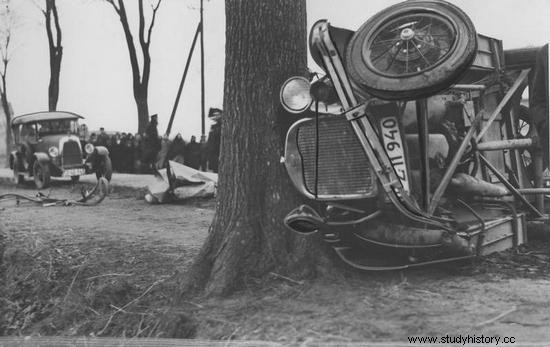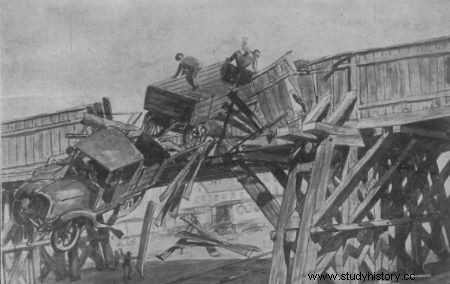In the Second Polish Republic, there was no penalty for drunk driving. The law was full of holes, the social consent was 100%, and the accident statistics were appalling.
Drunken chauffeur, perpetrator of a terrible disaster. One killed, two seriously injured - shouted the headline of one of the issues of the Lodz "Echo" from 1930. A drunk chauffeur ran over the mayor! - reported newspapers from Katowice at the same time. A taxi crash in Warsaw. 1 killed and 3 wounded - alarmed "Express Wieczorny Ilustrowany", immediately adding that the perpetrator was a drunk taxi driver.
"Głos Poranny" from 1928 presented the history of the capital city:a drunk driver of a truck belonging to a well-known factory of mortars and shoe polish, "Bright sun" he demolished half of Wspólna Street. He was stopped only by a persistent pursuit of ... four policemen on bicycles and no less determined pedestrian patrols who commandeered two taxis (Polish police still had very little of their own cars).
Finally, "Ilustrowana Republika" from 1932 told about an accident caused by a wounded soldier who crashed into a horse cart carrying 21 people in a speeding military car. A quarter of the collision victims died, the rest were hospitalized.

And that's how you often ended up driving on dual throttle.
There were hundreds or even thousands of similar incidents in the interwar period - although no one kept exact statistics.
Gruesome stats
It can be safely said that the problem of drunk drivers has been the bane of Polish roads since the automotive revolution.
In 1925, "Lodzkie Echo Wieczorne" alarmed: at least 75 percent of all car accidents occur because of the drunk driving condition! Even so, it took years for the law to catch up with reality.
Cars began to gain popularity in Poland already before World War I, while the first regulations prohibiting drunk driving appeared only in the regulation of the Minister of Public Works and the Minister of the Interior of January 1928. Paragraph 50 of that act stated:"It is forbidden for the driver to drive while drunk".
Dead Law
Unfortunately, as is often the case in Poland, it was a completely dead recipe , established mainly due to international agreements. Not only does the regulation not specify exactly what "intoxication" is, but also does not provide for ... any specific penalty for driving a vehicle sucks. As a result, drivers could feel unpunished until they caused a serious accident. At that time, however, they were punished not for driving under the influence, but for careless driving, violating other laws or unintentionally injuring the body, and in the worst case scenario - causing death.

When drunk, it's easy to be a disaster. You can, for example, fly off a bridge. Spectacular.
The leaky provision was not specified in any of the subsequent pre-war regulations. Most of the problem resulted from a lack of will, but also from the elementary ignorance of our politicians. Of course, there were no breathalysers in the interwar period, but that doesn't mean that you couldn't test your blood alcohol level at all.
In other countries (Sweden, Denmark, Belgium), as early as the 1930s, it was the norm to equip police officers with portable blood collection kits. The samples were obtained by the officers themselves at the scene of the collision by: pricking the tip of the perpetrator's finger with a suitable instrument . The blood was then tested by police chemists and, if you believe the professor at Stefan Batory University, Dr. S. Schilling-Siengalewicz, the results were amazingly accurate - even from today's perspective.
Pre-war breathalysers
Also, the scale of alcohol intoxication, which was operated at that time, did not differ much from the present one. Only the first bar was raised a bit higher than today: according to pre-war specialists, only one blood alcohol content in the blood was starting to adversely affect the ability to drive vehicles .
How was it for comparison in Poland? Poorly. The intoxication of drivers was described "by eye", the courts tried to downplay the arguments about the intoxication of chauffeurs, and the motorists themselves drank excessively.
It was not until 1939 that the authorities recognized the problem of drunk drivers as a convenient substitute topic. A ruthless fight against alcohol intoxicated "murderers" was announced. For example, any taxi driver suspected of drinking at work ... would be sent to the hospital for gastric lavage! Before this crusade could take effect, however, World War II had broken out.
Sources:
Press:
- "Echo", 1930, 1932, 1935, 1938.
- "Express Wieczorny Ilustrowany", 1935.
- "Głos Polski", 1928.
- "Głos Sądownictwa", 1934.
- "Illustrated Republic", 1932.
- "Lodzkie Echo Wieczorne", 1925.
- "Daily News", 1933.
- "Development", 1931.
- "Warsaw National Journal", 1939.
Studies:
- Magdalena Pyter, Legal rules for the use of motor vehicles in the Second Republic of Poland , "Journal of Law and History", vol. LXIII (2011), issue 3.
Legal acts:
- Regulation of the Minister of Public Works and the Minister of the Interior in consultation with the Minister of Military Affairs of 27 January 1928 on the traffic of motor vehicles on public roads , Journal of Laws 1928 No.41, item. 396.
- Regulation of the Minister of Communication and the Minister of the Interior in consultation with the Minister of Military Affairs of January 15, 1933 on the traffic of motor vehicles on public roads , Journal of Laws 1933 No.9, Item. 55.
- Regulation of the Ministers of Communication, Interior and Military Affairs of October 27, 1937 issued in agreement with the Minister of Social Welfare on the traffic of motor vehicles on public roads , Journal of Laws 1937 No.85, item. 616.
